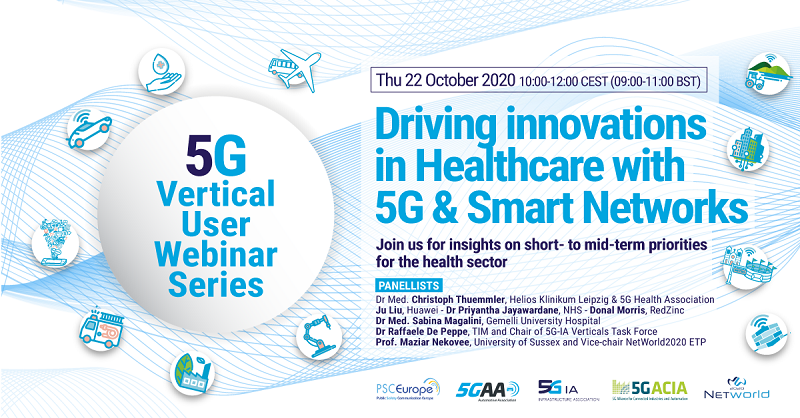Driving Innovation in Healthcare with 5G and Smart Networks

The webinar, Driving Innovation in Healthcare with 5G and Smart Networks, on 22 October 2020 was co-hosted by the Full5G project, the 5G Infrastructure Association and the NetWorld 2020 European Technology platform. It looked at the case for 5G in healthcare with concrete use cases, adoption potential and roadmaps with viewpoints from medical perspectives, including PANACEA. Further insights came from the vendor side, SME innovations and research perspectives with on-going trials in Europe and China.
Interactive discussions focused on top priorities in the short- to mid-term and the roles of governments and funding agencies in supporting the adoption of 5G and smart networks in the years ahead with end-user validation high on the agenda.
Takeaways
Prof. Dr Med. Christoph Thuemmler, Clinician at Helios Klinikum Leipzig & 5G Health Association: The webinar drew attention to examples of 5G trials and pilots in care homes, hospitals and emergency services in China, Finland, Germany, Ireland, Italy and the UK as catalysts for further uptake. Coming together as a multi-stakeholder community is extremely important. 5G-IA is playing an instrumental role in supporting dialogue in healthcare. The webinar also highlighted the consensus on the need for further investments and huge priority for getting 5G projects in the sector off the ground. Presentation: Driving Innovation in Healthcare with XG and Smart Networks
Dr Med. Sabina Magalini, Senior Surgeon at the Gemelli University Polyclinic and PANACEA coordinator underscored the many possibilities for 5G-enabled innovations in the sector and an opportunity to make healthcare more sustainable as the virtualisation of healthcare gains momentum. Much needs to be done at policy level to drive hospital adoption roadmaps that ensure widespread uptake. She also highlighted 5G as being an important enabler for Telehealth applications where QoE is an important aspect; remote robotic surgery, protective discharge for patient monitoring and treatment post-hospitalisation; AI-based applications and user-centric approaches. The PANACEA Secure Behaviour Nudging Tool, designed to improve cybersecurity behaviour in healthcare from a human perspective, could also be used to overcome mindset barriers and resistance to change.
Ju Liu, Huawei stressed the importance of working together to understand the priorities, scenarios and requirements that are specific to healthcare with related parameters, affordable solutions with the right amount of funding and investments. Presentation: 5G for Health - Driving Innovations in Healthcare with 5G and Smart Networks
RedZinc’s BlueEye Clinic video consultation software is a primary example of how COVID-19 has been a catalyst for the introduction and acceleration in healthcare services and is now used nationwide in HSE Ireland. CEO, Donal Morris, sees 5G as an opportunity for an effective engagement model, where we have APIs to acquire network slicing, a governance model and service model and anything else that is needed to enable IT providers to use the 5G infrastructure to make end-to-end services work. This could be the way forward that works for carriers and delivers better end-user services, which would make a better supply chain. Presentation: 5G Wearable Video for Paramedics in the 5G-HEART Project
Prof. Maziar Nekovee from the University of Sussex and NetWorld 2020 emphasised the mid-term research priorities for healthcare to unleash the full potential of 5G and beyond 5G in the 2025-2030 timeframe, such as digital twins. Research on future smart networks needs to start now. Presentation: Connected and intelligent care: Findings from care homes
The webinar chairs, Stephanie Parker and John Favaro from Trust-IT, concluded by stressing the fundamental importance of funding and cost models so we understand what’s affordable and what’s realistic, as well as audience points on the need to thoroughly investigate concerns about data ownership and IP rights. AI is fundamental in using 5G, so there is a risk if we don’t rethink the ownership of the tools and their abstractions.
